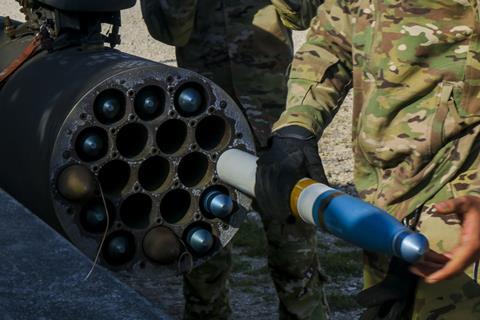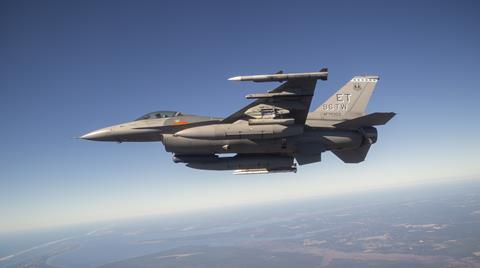The United States military is embarking on a significant modernization effort with its recent plans to procure tens of thousands of low-cost guided rockets from BAE Systems. This strategic move, part of the Pentagon’s comprehensive initiative to counter emerging threats from inexpensive and effective battlefield drones, reflects a growing recognition of the evolving nature of warfare.
On August 28, the Pentagon announced a contract with BAE Systems to purchase up to 55,000 Advanced Precision Kill Weapon System (APKWS) II rockets for approximately $1.7 billion. Deliveries of these advanced munitions are scheduled to continue until the end of 2031. This formidable investment underscores the military’s commitment to enhancing its capabilities in a rapidly changing battlefield environment.
Originally developed as an unguided air-launched munition, the 70mm (2.75in) APKWS has been in service for decades. However, the recent enhancements brought by the APKWS II—featuring a semi-active laser-guided capability—represent a leap forward in effectiveness and precision. This rocket can now target and engage adversaries with greater accuracy, making it an invaluable asset in modern combat scenarios.

Initially deployed by attack helicopters, such as the Bell AH-1Ys, Boeing AH-64D/Es, and AH-6s, the APKWS has found new life in the fight against evolving threats, particularly in the realm of drone warfare. Recent conflicts, from the 2020 Nagorno-Karabakh war to ongoing hostilities between Russia and Ukraine, have highlighted the pivotal role of drones on the modern battlefield.

The advent of small, commercially available quadcopters has shifted their initial roles from mere reconnaissance to lethal engagement tools. In Ukraine, operators have utilized “first-person view” drones to successfully strike armored vehicles and inflict significant casualties on enemy troops. Moreover, these drones played a pivotal role in the clandestine operations targeting Russian bombers, showcasing the dramatic impact of drone warfare.
Russia and Iran have pushed the boundaries further by innovating long-range “suicide” or “kamikaze” drones designed to deliver devastating blows to cities and key infrastructure. These systems are often produced at a fraction of the cost of traditional military hardware, highlighting a growing asymmetry in modern warfare where inexpensive drones can challenge traditional platforms.
This scenario demands a reassessment of how militaries counter aerial threats. Conventional air defense systems find themselves quickly overwhelmed by the sheer number of drones, prompting a shift in strategy from expensive interceptor missiles to more cost-effective solutions like the APKWS II.
According to Jason Lambert, president of intelligence, surveillance, and reconnaissance at L3Harris, the small-scale size of the APKWS rockets allows for an attractive price point per shot, making them economically viable for maintaining effective air defense capabilities. The development of ground-based defensive systems, such as L3Harris’ Vampire, demonstrates how these guided rockets can effectively counter drone threats.
The Vampire system combines APKWS launchers with advanced targeting technology, allowing troops to engage hostile drones effectively. It has already been deployed in the Ukraine conflict, illustrating its utility on the battlefield. Additionally, L3Harris is exploring naval applications of the Vampire system, further broadening its potential utility.
The financial implications of this shift are significant. Each APKWS rocket costs around $35,000, a fraction of the cost of traditional guided missiles, such as Raytheon’s AIM-120 AMRAAM or AIM-9X Sidewinder, which can run into the hundreds of thousands or even millions of dollars per unit. This cost-effectiveness is vital for maintaining operational readiness amid rising drone threats.

Moreover, the military is integrating APKWS with existing platforms for enhanced air defense capabilities. For instance, the US Air Force has successfully adapted the rockets to Lockheed Martin F-16 fighter jets, allowing pilots to engage one-way drones in combat scenarios. This adaptability ensures that the APKWS system can be utilized effectively across various platforms and situations.
BAE Systems has boasted that its APKWS rocket pods are compatible with more than 45 platforms, reinforcing their versatility and operational flexibility. In a testament to this adaptability, BAE recently demonstrated the capability of small quadcopters to launch APKWS rockets, proving that even unmanned systems can leverage this advanced munition effectively.
As the Pentagon furthers its commitment to counteracting drone threats, it has established a new task force—the Joint Interagency Task Force 401—to coordinate efforts across various defense offices tackling the growing vulnerability posed by small unmanned aerial systems. Defense Secretary Pete Hegseth has stressed the critical need for a unified approach to address these threats, signifying a strategic shift in how the U.S. military perceives and responds to modern warfare challenges.
With the drone warfare landscape rapidly evolving, the Pentagon’s investment in APKWS II rockets marks a pivotal moment in the transition to more practical, cost-effective defensive solutions. This procurement will likely redefine the United States’ capabilities in responding to asymmetric threats on the modern battlefield.

